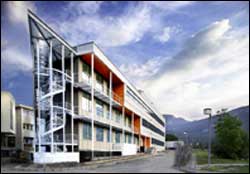A European Centre for Structural Biology inaugurated in Grenoble

The new Carl Ivar Braendén building.
On 13 January the new Carl-Ivar Brändén Building (CIBB) will be inaugurated on the Polygone Scientifique Campus in Grenoble, France. The CIBB will be operated as a collaboration between major international and national partners based in Grenoble and is a further step in the development of the region as a European centre of excellence for structural biology.
The CIBB comprises two complementary units: the Partnership for Structural Biology (PSB), whose members include the European Molecular Biology Laboratory (EMBL), the European Synchrotron Radiation Facility (ESRF), the Institut de Biologie Structurale (IBS) and the Institut Laue-Langevin (ILL), and the Institut de Virologie Moléculaire et Structurale (IVMS, associated with the Université Joseph Fourier and the CNRS).
“These partners offer an amazing range of expertise in the life sciences, and the Grenoble campus is an ideal place to cluster them together in an important new centre for structural biology”, says Eva Pebay-Peyroula, Director of the IBS and current Chair of the PSB. “It benefits from the presence of some of the world’s most important instruments for structural biology: the ESRF’s X-ray source is one of the most powerful in the world, and the ILL offers the world’s leading source of neutrons.”
For many years the ESRF, ILL and EMBL have collaborated in offering scientists services and training connected to these instruments, already making the site a pivotal contact point for large European research projects and interdisciplinary collaborations.
The CIBB will house research groups and a complete pipeline for carrying out high-throughput structural investigations of proteins and other molecules, with a particular focus on molecules related to human diseases. The facilities include laboratories for high-throughput protein purification and expression, robotic crystallisation facilities, deuteration and isotope labelling, nuclear magnetic resonance, mass-spectrometry and cryo-electron microscopy.
“By assembling all the components of this pipeline in a unique platform under one roof, we can greatly speed up the process of investigating molecules and processes relevant to diseases,” says Rob Ruigrok, Professor at the Université Joseph Fourier and Director of the IVMS.
One example of work to be carried out at the CIBB will be the molecular and cellular basis of viral diseases. Researchers plan to investigate, for example, proteins on the surfaces of viruses which allow them to dock onto receptor proteins, and then gain entry into human cells. Once inside, the virus hijacks crucial cellular processes and eventually destroys the host, following a range of molecular interactions.
Investigating the key steps in these processes should allow the identification of specific molecular reactions that may be potential drug targets. Designing efficient inhibitors will require three-dimensional structures – atom-by-atom maps of proteins and other molecules. The necessary level of resolution cannot be obtained with microscopes, so scientists turn to high-intensity X-ray beams, like those produced by the ESRF, and neutrons from the ILL. The many types of skills and expertise necessary for such analyses of molecular structures have now been brought together in the CIBB.
This strategy of combining complementary expertise already has proven itself in past collaborative projects between the institutes. For example, since the PSB was founded in 2002, scientists have obtained crucial insights into fundamental biological processes that play a role in disease, and as part of the EU SPINE (Structural Proteomics in Europe) project, the PSB has produced potential drug targets in the battle against disease-causing bacteria and viruses.
“The CIBB is a concrete manifestation of the interdisciplinary and international scientific collaboration necessary today to push forward fundamental disease research in this new era of high-throughput biology” says Stephen Cusack, Head of EMBL’s Outstation in Grenoble. “It received generous funding from the European Union’s Framework Programme”.
Media Contact
More Information:
http://www.esrf.fr/NewsAndEvents/PressReleases/CIBBAll latest news from the category: Life Sciences and Chemistry
Articles and reports from the Life Sciences and chemistry area deal with applied and basic research into modern biology, chemistry and human medicine.
Valuable information can be found on a range of life sciences fields including bacteriology, biochemistry, bionics, bioinformatics, biophysics, biotechnology, genetics, geobotany, human biology, marine biology, microbiology, molecular biology, cellular biology, zoology, bioinorganic chemistry, microchemistry and environmental chemistry.
Newest articles

Properties of new materials for microchips
… can now be measured well. Reseachers of Delft University of Technology demonstrated measuring performance properties of ultrathin silicon membranes. Making ever smaller and more powerful chips requires new ultrathin…

Floating solar’s potential
… to support sustainable development by addressing climate, water, and energy goals holistically. A new study published this week in Nature Energy raises the potential for floating solar photovoltaics (FPV)…

Skyrmions move at record speeds
… a step towards the computing of the future. An international research team led by scientists from the CNRS1 has discovered that the magnetic nanobubbles2 known as skyrmions can be…





















